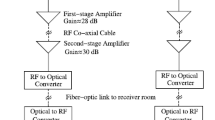Abstract
THE experiments of Bolton and Stanley1, and of Ryle and Smith2,3, using a radio interferometer have shown that a significant part of the extra-terrestrial radio noise is associated with point sources with diameters of less than 6 minutes of arc. Although the majority of these sources are unidentified with visual objects, their distribution indicates that they lie in our own galaxy. Attempts to detect radio emissions from specific extra-galactic objects have hitherto been unsuccessful. In this communication we describe the results of an experiment to detect radio emissions from the Andromeda Nebula (M.31) using a narrow pencil-beam aerial and high-sensitivity receiving equipment.
Similar content being viewed by others
References
Bolton and Stanley, Nature, 161, 312 (1948); 162, 141 (1948).
Ryle and Smith, Nature, 162, 462 (1948).
Ryle, Phys. Soc. Rep. Prog. Phys., 13, 184 (1950).
Ryle and Vonberg, Proc. Roy. Soc., A, 193, 98 (1948).
Reber, Astrophys. J., 100, 279 (1944).
Bolton and Westfold, Aust. J. Sci. Res., 3, 19 (1950).
Author information
Authors and Affiliations
Rights and permissions
About this article
Cite this article
BROWN, R., HAZARD, C. Radio-frequency Radiation from the Great Nebula in Andromeda (M.31).. Nature 166, 901–902 (1950). https://doi.org/10.1038/166901a0
Issue Date:
DOI: https://doi.org/10.1038/166901a0
- Springer Nature Limited
This article is cited by
-
Extragalactic radio continuum surveys and the transformation of radio astronomy
Nature Astronomy (2017)
-
Radio-Frequency Radiation from the Spiral Nebula Messier 81
Nature (1953)
-
Radio-Frequency Radiation from Tycho Brahe's Supernova (A.D. 1572)
Nature (1952)
-
Solare und kosmische Radiowellen
Experientia (1952)
-
The New Science of Radio Astronomy
Nature (1951)




